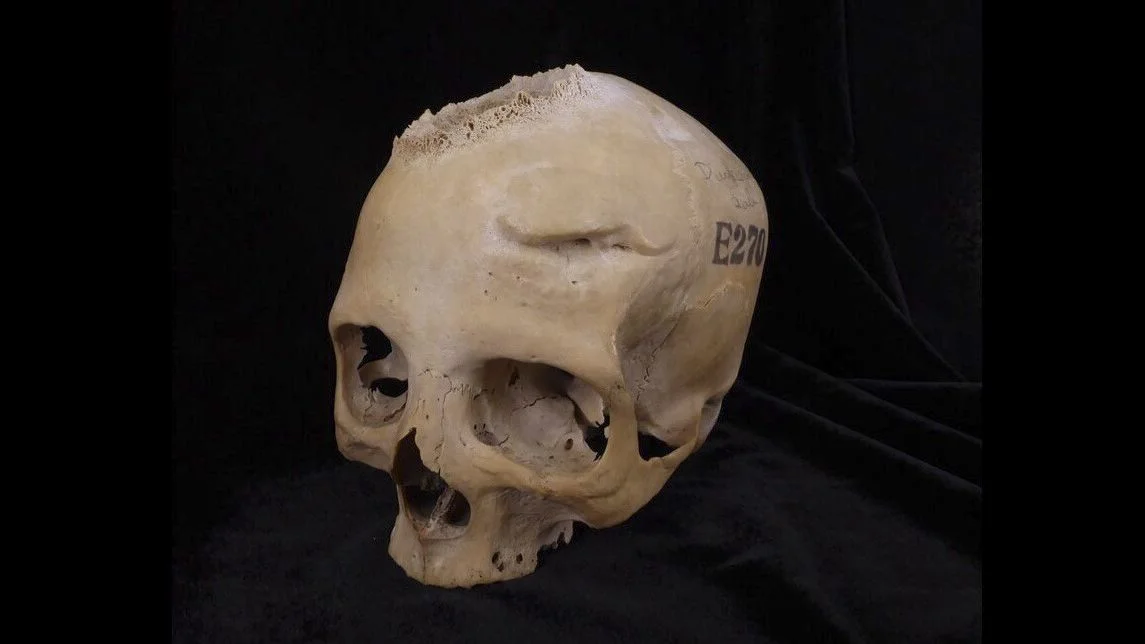Cancer is often seen as a modern affliction, but ancient Egyptian medical texts suggest that healers from that era were aware of the condition.
Recent discoveries from a skull that is over 4,000 years old indicate that ancient Egyptian physicians may have attempted to treat certain cancers with surgical methods.
The skull, belonging to a man who was approximately 30 to 35 years old at the time of his death, is housed in the Duckworth Laboratory collection at the University of Cambridge in the UK.
Scientists have been studying the skull’s scarred surface since the mid-19th century, noting multiple lesions believed to represent bone damage caused by malignant tumors.
Archaeologists classify this skull, cataloged as 236, as one of the oldest known examples of malignancy from the ancient world, dating from between 2686 BC and 2345 BC.
Recent examination of the tumor scars using a digital microscope and micro-computed tomography (CT) scans revealed cut marks around the tumors.
Dr. Edgard Camarós, a senior study author and professor of history at the University of Santiago de Compostela in Coruña, Spain, remarked, “It was the very first time that humanity was dealing surgically with what we nowadays call cancer.”
However, it remains uncertain whether the tumors were removed while the patient was still alive or if the removal occurred posthumously for analysis.
Camarós explained, “If those cut marks were done with that person alive, we’re talking about some kind of treatment directly related to the cancer.”
Conversely, if the cut marks were made after death, it would suggest a medical autopsy. “Either way, it’s amazing to think that they performed a surgical intervention,” he added. “But we cannot actually distinguish between a treatment and an autopsy.”
Several metastatic lesions on skull 236 exhibit cut marks. A close-up of these marks, likely made with a sharp object, is shown.
Medical knowledge and expertise in ancient Egypt, as documented in texts such as the Ebers Papyrus and the Kahun Papyrus, were notably advanced.
Dr. Ibrahem Badr, an associate professor in the department of restoration and conservation of antiquities at Misr University for Science and Technology in Giza, Egypt, who was not involved in the study, highlighted that ancient Egyptian medicine was not exclusively reliant on herbal remedies but also on surgical practices. “It directly relied on surgical practices,” he said.
While earlier research extensively covered ancient Egyptian medicine, 21st-century technologies, like those used in this study, are uncovering new details about ancient Egyptian medical practices, Badr noted.
“The research provides a new and solid direction for reevaluating the history of medicine and pathology among ancient Egyptians,” he said.

The research team also discovered cancer lesions in a second skull from the Duckworth collection. Cataloged as E270 and dating from 664 BC to 343 BC, this skull belonged to a woman who was at least 50 years old.
The team identified three lesions on the specimen where malignant tumors had caused bone damage.
Unlike skull 236, skull E270 showed no evidence of surgical intervention related to the disease. However, it did exhibit long-healed fractures, indicating successful prior treatment for head injuries. “That person survived many years after that trauma,” Camarós said.
The analysis of these skulls offers significant insights into the field of pathology and the development of medicine in ancient Egypt. Badr, who works with European and American scientists studying atherosclerosis in ancient Egyptian mummies, explained that detailed examinations using modern technologies such as CT scans and DNA sequencing aim to further reveal the extent of ancient Egyptian medical knowledge.
“There is an urgent need to reevaluate the history of Egyptian medicine using these scientific methodologies,” Badr said. “By utilizing these modern techniques, we will be able to study and gain a more comprehensive and precise understanding of medicine in ancient Egypt.”
The new findings also contribute to the “obscure biography” of cancer, adding a chapter from thousands of years ago. Camarós noted, “The more we look into our past, the more we know that cancer was much more prevalent, much more present than we thought.”
Ancient Egyptians perceived cancer through the visible tumors it produced. The earliest recorded observation of cancer is found in the Edwin Smith Surgical Papyrus, an ancient Egyptian medical text from around 3000 BC to 2500 BC, which includes 48 case studies of various ailments, including breast cancer.
Although ancient Egyptians may have recognized cancer, treating it was a different challenge. The Edwin Smith Papyrus mentions medicines and strategies for various conditions but lacks specific treatments for breast cancer tumors.
“It specifically says there’s no treatment,” Camarós said. “They realized this was a frontier when it came to their medical knowledge.”
The incisions around the skull tumors suggest that ancient Egyptian healers might have attempted to address this challenge, either by surgically removing the tumors to treat the patient or to study the tumors more closely.
“We have these two possibilities: in a way that they tried to treat it, or in a way that they tried to medically understand it, in terms of probably treating it in the future,” Camarós said. “I think that’s a milestone in the history of medicine.”
